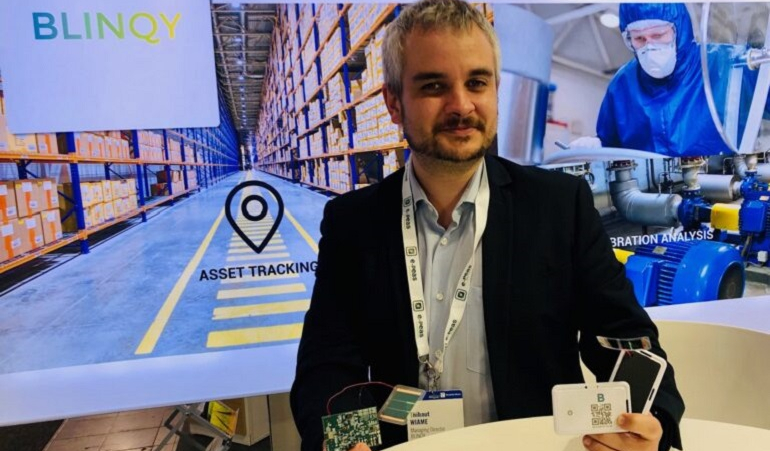
To monitor connected objects, find out their location or track their wear and tear, a small tracker, called a 'tag' in the jargon, proposed by an innovative company from Charleroi, can be very useful.
"We have been offering our customers tags that communicate via Bluetooth since 2020," explains Thibaut Wiame, Director of Blinqy. A graduate of the Leuven School of Management and now an expert in communications, the entrepreneur has spent the last few days in Hannover. From the WBI (Wallonia-Brussels International) and AWEX (Wallonia Export-Investment Agency) stand at the annual Hannover Messe industrial fair, Thibaut Wiame explains his technology.
A stand-alone device with very low energy consumption
"We design and produce connected tags that are then sold to integrators. On request, we can also equip them with various sensors, such as temperature, movement, and angle, pressure and CO2 detection. We also develop embedded software. This makes it possible to track and then locate goods, equipment or even people," he says.
Is there nothing new in terms of the IoT (Internet of Things/connected objects)? "On the contrary," the entrepreneur insists, "we specialise in the low energy consumption of these devices. This is the added value we offer."
"Our bugs communicate their data via Bluetooth low-power technology. This allows us to offer devices with long lifetimes. As a result of our research and development work, and unlike the tags currently available on the market, which have an average life span of one to two years, our devices operate two to three times longer for object detection in closed buildings. This is for devices with a single-use lithium battery."
Light to the rescue
Going from a life expectancy of two years to four or six years is already significant. But the company's R&D is not stopping there. "We are currently developing a stand-alone tag with two partners in France and Belgium. It will have a rechargeable battery and a small integrated photovoltaic panel. This tool is also equipped with an additional chip that optimises battery charging," says Blinqy's director. "This ensures greater autonomy for the device, whose life span becomes almost infinite, at least as long as there is light."
The company is therefore focusing on innovation. It provides the tag, the consultation for its optimal use, the real-time localisation of the tag, and therefore of the object with which it has been equipped. This technology component is sold to integrators and customers in Europe and North America, who use it for a wide range of applications. It can be used to track a mobile device or monitor the vibrations of a machine to assess its operational status and wear. Its possible overheating, which can lead to a loss of productivity. Tracking batches of goods. Or even to track a patient in a hospital with precision.
Connected patients
"People who are hospitalised are usually fitted with a bracelet," the contractor recalls. "This is used to identify them, better monitor the treatments and the sequence of examinations required, and know where they are at a specific time. With connected bracelets, these checks can take place in real time while reducing the risk of errors," he argues.
The icing on the cake is that the Walloon company is also working on optimising the data transmitted by its bugs. This will reduce data consumption. "At least the data transmitted to the end-users' cloud, so that they only have the most relevant information," concludes Thibaut Wiame.
This article was written by Christian Du Brulle for the Daily Science platform, with the support of Wallonia-Brussels International, as part of Hannover Messe 2023.